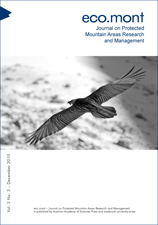Pascal Querner,
Alexander Bruckner,
Erich Weigand,
Markus Pösch
S. 29 - 36
doi:
10.1553/eco.mont-2-2s29
Verlag der Österreichischen Akademie der Wissenschaften
doi:
10.1553/eco.mont-2-2s29
Abstract:
We compared the Collembola communities of three sub-alpine sites in the Limestone Alps to evaluate the short- and long-term effects of natural forest fires. SITE 1 was burned in August 2003, SITE 2 was burned 50 years ago and sampled to assess the long-term effects of fire and the recovery of soil animals. A reference site (REF) was sampled to represent the undisturbed dwarf pine community. All sites are close to each other on a steep slope between 1 400 and 1 650 m above sea level. We found a total of 41 species of Collembola, as well as clear differences in the species composition and abundance between the sites. Most species (29) were found on the REF site. The highest abundance was found on SITE 1 (48 960 individuals*m-2, 22 species). We assume that some species survived the fire in deeper soil layers and others migrated or were passively dispersed from unburned patches and surrounding sites. The lowest abundance and species number (8 160 individuals*m-2, 18 species) were found on the 50-year-old site. This site was covered with a typical community for moving substratum, consisting mainly of alpine grasses, yet the dwarf pine vegetation had not yet recovered. The soil layer was still very thin and we therefore assume that a recovery of the Collembola community will take much longer than 50 years.
fire ecology, springtails, succession, Kalkalpen National Park
Published Online:
2010/11/24 14:59:50
Object Identifier:
0xc1aa5576 0x0024d22d
Rights:https://creativecommons.org/licenses/by-nc-nd/4.0/
The journal “eco.mont” – Journal of protected mountain areas research and management – was published for the first time in June 2009.
The journal was founded as a joint initiative of the Alpine Network of Protected Areas (ALPARC), the International Scientific Committee on Research in the Alps (ISCAR), the Austrian Academy of Sciences (ÖAW) and the University of Innsbruck.
The journal aims to highlight research on and management issues in protected areas in the Alps without excluding other protected mountain areas in Europe or overseas. Its target audiences are scientists from all related disciplines, managers of protected areas and interested individuals including practitioners, visitors, teachers, etc.
The journal presents peer-reviewed articles in English by authors who research protected mountain areas and management issues within these areas. It's published twice a year as a collaboration of the Austrian Academy of Sciences Press – responsible for the e-version – and Innsbruck University Press – responsible for the print version.
Die Zeitschrift „eco.mont“ – Zeitschrift zur Forschung in Gebirgsschutzgebieten – erschien im Juni 2009 zum ersten Mal. Die Zeitschrift wurde auf Initiative des Netzwerks Alpiner Schutzgebiete (ALPARC), der Schweizer Akademie der Naturwissenschaften (ISCAR), der Österreichischen Akademie für Wissenschaft (ÖAW) und der Universität Innsbruck gegründet. Sie hat das Ziel, Themen zu behandeln, die gleichzeitig Forschung und Verwaltung in und über die Schutzgebiete der Alpen betreffen, ohne dabei andere Gebirgsschutzgebiete Europas oder anderswo auszuschließen. Diese neue Zeitschrift richtet sich an ein Publikum von Wissenschaftlern der verschiedensten Fachbereiche, an die Verwalter von Schutzgebieten und an alle sonstigen Interessierten, Praktiker, Besucher, Lehrpersonal etc. einbegriffen. Die Zeitschrift veröffentlicht begutachtete Beiträge auf Englisch von Autoren, die Fragen der Gebirgsschutzgebieten und deren Verwaltung forschen. Sie erscheint zweimal pro Jahr, auf der Basis der gemeinsamen Anstrengungen des Verlags der Österreichischen Akademie der Wissenschaften, der für die digitale Fassung verantwortlich ist, und der Presse der Universität Innsbruck, verantwortlich für die gedruckte Fassung.



 Home
Home
 Print
Print
 References
References
 Share
Share

